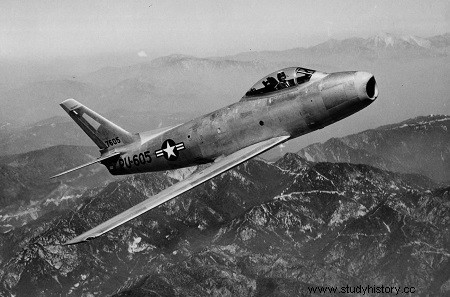
The Communist pilots were inexperienced, but it soon became apparent that the Mig-15 would dominate all Allied aircraft. In any case, this was the impression of the Americans, seized with panic; . they ordered the urgent deployment to Korea of the 4th Fighter Interceptor Group equipped with the new F-86A Sabers (the unit arrived in Korea at the beginning of December). The performance of the Saber was close to that of the Mig-15. The lighter Soviet fighter, however, had a better rate of climb and maneuvered tighter. Its armament consisted of three guns (two of 23 mm and one of 37 mm) of which only one shell could cut down the adversary; but it fired at a third of the rate of the F-86's six machine guns. In fact, the mediocrity of the Chinese pilots and the valor of the American pilots made the combat unequal.
Korea was therefore the scene of the first jet combat. It took place on November 7, 1950, between a MiG-15 and an F-80. Despite the theoretical superiority of the communist fighter, it was the F-80 that prevailed, bringing down its adversary in a dive attack. On December 17, a Saber shot down a MiG-15. Over the next two and a half years, the Sabers "knocked down" 791 MiG-15s. In all, 807 MiGs were destroyed in Korea - against 78 Sabers:the ratio of losses, in favor of the Allies, therefore reached the considerable proportion of twelve and a half against one!
These air battles recalled those of World War II. The parameters differed, with altitudes of 3000 m and speeds up to 1100 km/h, but the conditions and tactics hardly changed. There was no ground control, no radar (except, in the case of the F-86, an APG-30 fire control radar), no brazen craft—nothing unfamiliar to a pilot. of the Battle of Britain! Navigation was done by reconnaissance of the ground from maps, or more roughly by estimation. The fuel consumption calculation depended on the pilot's skill in estimating his range. For the interception, he only had his own vision. The battle engaged, the speed fell around 600 - 700 km/h until one of the protagonists tried to escape (by acceleration) or was shot down. Victory invariably went to the best driver. It should also be noted that the experiences that followed (Indo-Pakistani war, Vietnam, Middle East) showed that the fundamental conditions of air combat had not changed. After Korea, the Americans believed in a new era of aerial warfare:radar combat, at long range, by air-to-air vehicles. But they met in Vietnam with a cruel denial.
